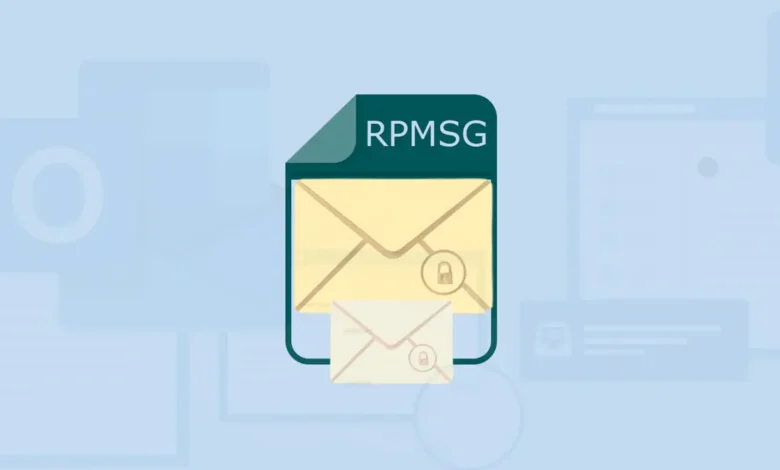Understanding RPMSG: A Deep Dive Into Microsoft’s Restricted Permission Message Format

In the ever-evolving digital communication landscape, data privacy and email security have become paramount. One of the significant innovations from Microsoft to address these concerns is the RPMSG file format, short for Restricted Permission Message. If you’ve ever encountered a .rpmsg file in your Outlook inbox, you’ve experienced this security protocol in action. In this article, we’ll explore everything you need to know about RPMSG files from their purpose and structure to how to open, send, and troubleshoot them. Whether you’re an IT admin, security enthusiast, or everyday Outlook user, this informative article will demystify RPMSG and help you understand its role in protecting sensitive data.
What is RPMSG? An Introduction to the Format
RPMSG stands for Restricted Permission Message, a file format developed by Microsoft to enforce rights management on email messages. When a user sends an email protected by Information Rights Management (IRM) in Microsoft Outlook, the message is converted into an .rpmsg file. Unlike regular emails, RPMSG files are encrypted and include usage restrictions. For example, a recipient might be allowed to read the email but prevented from forwarding, copying, or printing its contents. This is particularly useful for organizations that handle confidential or regulated data and must prevent accidental leaks or misuse. The RPMSG file is not just an encrypted container; it also contains metadata specifying the user rights, expiration dates, and audit trails, making it an essential part of Microsoft’s digital rights management ecosystem.
How RPMSG Works: The Technology Behind It
At a technical level, an RPMSG file encapsulates the email content and applies RMS (Rights Management Services) encryption. When a user sends a protected email, Outlook uses the Azure Rights Management or Active Directory Rights Management Services (AD RMS) to apply a specific rights template. The rights templates are what dictate what the recipient can do with the message. The RPMSG file is then embedded inside a standard email, often appearing as an attachment or rendering directly in the email client if supported. The encryption keys are never included in the file itself; instead, the recipient’s client must contact the RMS server for decryption rights. This ensures that even if the RPMSG file is intercepted during transmission or saved outside the email system, unauthorized users cannot read its contents. Microsoft uses secure tokens and certificate-based authentication to verify both the sender and recipient, adding multiple layers of protection.
Key Features of RPMSG Files in Email Communication
RPMSG files bring a wide range of security features to enterprise-level email communication. First and foremost, they support fine-grained permission control. Users can restrict recipients from forwarding, editing, printing, or copying content. In some cases, senders can even revoke access after the message is sent. RPMSG messages also include persistent protection, meaning the restrictions stay with the message even if it is saved outside of Outlook. Furthermore, they integrate seamlessly with Microsoft’s auditing and compliance tools, allowing administrators to track how messages are accessed and whether any policy violations occur. Another important feature is the ability to include expiry dates, after which the RPMSG message becomes unreadable. This is especially useful for time-sensitive or legally bound communications. Finally, because RPMSG is a Microsoft-proprietary format, it is deeply integrated with the Microsoft 365 and Exchange ecosystems, offering administrators centralized control over data protection policies.
How to Open RPMSG Files: Tools and Requirements
Opening an RPMSG file is straightforward if you’re using supported Microsoft software. The most reliable method is through Microsoft Outlook (2013 or newer), which automatically recognizes and decodes the RPMSG format if the user has the appropriate permissions. Users must be connected to the internet and signed in with an account that has access rights as defined by the sender or the rights management template. For those without Outlook, Microsoft offers a Rights Management Viewer, though it has limited support and is being deprecated in favor of browser-based decryption via Outlook on the web (OWA). Users accessing RPMSG files from mobile devices must use the Outlook app, as standard email clients like Gmail or Apple Mail do not support RPMSG natively. When opening an RPMSG file, users are typically prompted to authenticate via Microsoft Azure or AD RMS. Once authenticated, the message content becomes readable according to the permissions granted. If the recipient lacks access rights or is offline, the file remains inaccessible.
How to Send an RPMSG Email in Microsoft Outlook
Sending an RPMSG-protected email in Microsoft Outlook is a simple process, but requires configuration. First, your organization must have Rights Management enabled via Microsoft 365 Compliance or Azure Information Protection. Once this is set up, you can open a new email, write your message, then go to Options > Permissions, where you can choose from templates like “Do Not Forward,” “Confidential,” or “Company Confidential.” Once sent, the message is wrapped in the RPMSG container, encrypted, and only readable by recipients with the appropriate credentials. You can also customize permissions via Azure if the default templates do not meet your needs. The beauty of this system is that the sender doesn’t need to manually encrypt the message or generate keys; the entire process is handled automatically by Microsoft’s backend systems. If the message is accessed via an unsupported client, it will either display as a generic attachment or redirect the user to Outlook on the web, where it can be opened securely.
Common Problems with RPMSG Files and How to Troubleshoot Them
Despite its security advantages, RPMSG files can occasionally present usability issues. One of the most common problems is that users try to open them with an unsupported email client, resulting in a blank message or a “file not supported” error. Another issue is offline access; if the device cannot connect to the RMS server for key verification, the message cannot be opened. Problems may also occur due to outdated Outlook versions or improper configuration of Azure Information Protection. In some cases, enterprise firewalls or security software may block access to the RMS server, causing authentication failures. To troubleshoot RPMSG issues, first ensure you’re using a supported Microsoft client. Check internet connectivity and verify that the user’s account is properly licensed and has the necessary permissions. Administrators can use diagnostic logs in the Microsoft 365 compliance center to further investigate access errors. For users unable to open the file via desktop, directing them to Outlook Web Access often resolves the problem.
Security Benefits of Using RPMSG in the Enterprise Environment
For organizations dealing with confidential information, the use of RPMSG brings significant security enhancements. The format ensures that only authorized recipients can access message content, helping prevent both accidental and malicious data leaks. It’s a critical component of Data Loss Prevention (DLP) strategies, especially in industries like healthcare, finance, and legal services where compliance with regulations such as HIPAA or GDPR is non-negotiable. Moreover, RPMSG integrates with Microsoft Purview, allowing companies to classify and monitor sensitive communications centrally. Since RPMSG enforces usage restrictions at the file level, even exported or saved messages remain protected. This makes RPMSG an effective tool for secure collaboration across departments or even external partners, as long as identity management is handled correctly. In an age where email-based data breaches are increasingly common, RPMSG stands out as a proactive defense mechanism built directly into enterprise workflows.
RPMSG and Azure Information Protection: A Perfect Match
RPMSG works hand-in-hand with Azure Information Protection (AIP), a cloud-based solution that helps organizations discover, classify, and protect sensitive information. With AIP, administrators can create custom labels and rules that automatically apply rights management to outgoing messages. For example, emails containing certain keywords or attachments might be automatically encrypted and converted into RPMSG format. AIP’s integration with Microsoft 365 allows for real-time scanning, classification, and enforcement of policies without disrupting the user experience. Once a label is applied, the RPMSG email is generated behind the scenes, and the user simply clicks send. This automation not only increases compliance but reduces human error. Furthermore, AIP provides rich reporting and analytics tools to audit how RPMSG-protected messages are accessed and shared. This level of visibility is crucial for risk management and incident response, making RPMSG and AIP a powerful combination for data governance.
The Future of RPMSG in a Zero Trust Security Model
As more organizations adopt a Zero Trust security approach, technologies like RPMSG become even more relevant. In Zero Trust architecture, no entity—whether inside or outside the network—is automatically trusted. Every request for access is verified, including access to email messages. RPMSG supports this model by enforcing strict identity verification and access control for each message. Microsoft is continually updating its Rights Management offerings to integrate better with conditional access, multi-factor authentication, and identity governance platforms. Additionally, advancements in machine learning are being used to improve auto-classification and smart labeling of content, ensuring that messages requiring RPMSG protection are automatically detected. With increasing support for RPMSG in web and mobile environments, and deeper integration into Microsoft’s Defender and Compliance solutions, the future of RPMSG lies in being a seamless yet invisible guardian of enterprise communications.
Conclusion: Why RPMSG Matters in Today’s Digital World
RPMSG is not just a file format—it is a cornerstone of modern email security and digital rights management. By enabling granular control over who can access and share sensitive emails, it helps organizations safeguard critical data in a way that is both user-friendly and highly secure. With its integration into the Microsoft 365 ecosystem, support from Azure Information Protection, and compatibility with enterprise compliance tools, RPMSG stands as a robust solution for regulated industries and security-conscious businesses. As threats become more sophisticated and data privacy becomes a competitive differentiator, adopting RPMSG and understanding its inner workings can offer not just protection but also peace of mind. Whether you’re an individual trying to secure your communication or a CIO building a security-first culture, RPMSG is a technology worth leveraging.
FAQs:
Q1: RPMSG file kya hoti hai?
A1: RPMSG ek encrypted email file hoti hai jo Microsoft Outlook mein send ki jaati hai jab aap “Do Not Forward” ya “Confidential” permission lagate hain.
Q2: RPMSG file kaise open karein?
A2: RPMSG file ko Microsoft Outlook (desktop ya web) mein open kiya ja sakta hai, agar aapke paas sahi permissions ho aur aap online ho.
Q3: Kya RPMSG email ko forward ya print kar sakte hain?
A3: Nahi, agar sender ne forward ya print ki permission disable ki ho, to RPMSG email ko aap forward, copy, ya print nahi kar sakte.
Q4: RPMSG sirf Outlook ke liye hi hoti hai?
A4: Haan, RPMSG format Microsoft Outlook aur Microsoft 365 ke liye design kiya gaya hai. Dusre email clients isse support nahi karte.
Q5: Agar RPMSG file nahi khul rahi to kya karein?
A5: Ensure karein ki aap Microsoft account ke sath sign-in hain, internet connected hai, aur Outlook ka updated version use kar rahe hain.



